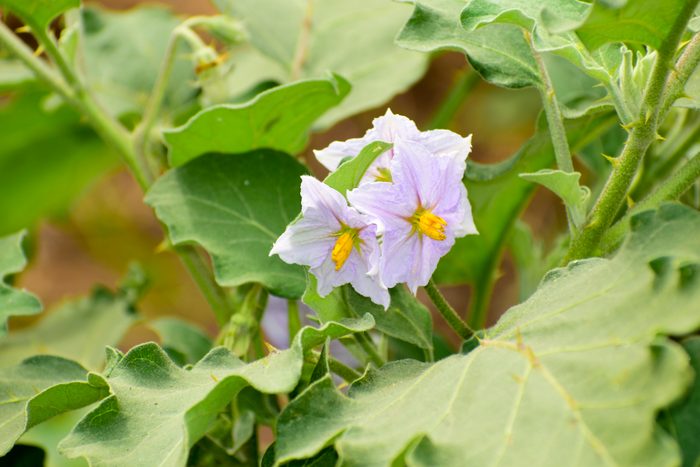In my kitchen garden, eggplant, or aubergine as it’s known in Europe, is a superstar. It’s easy to grow, especially the Asian varieties. It’s great in stir fries, like Thai spicy eggplant, or in Italian dishes like eggplant parmesan.
How to Plant Eggplant
From transplants, outdoors
Buy transplants from your local nursery or box store. Before buying, research online for disease-resistant varieties.
- Plant eggplant in full sun after your last average frost date, when the temperature is consistently warm.
- Dig a hole larger than the transplant in good, healthy, well-drained soil.
- Plant at the same level the transplant was in its container.
- Stake plants so they don’t fall over when loaded with fruit.
- When planting, add a handful or two of compost to the hole, mixing it into the soil around your plant.
- Cutworms can be a problem, but that’s easily averted at planting time. Push a large nail or the plant tag down into the soil next to the plant stem. If the cutworm can’t fold itself into a “C,” it can’t cut off the stem.
- Eggplant grows to two to three feet tall and wide, so space plants 24 to 36 inches apart to increase harvests. Proper spacing also prevents disease.
From seeds, indoors
- Start eggplant seeds indoors eight to 10 weeks before transplanting outside.
- Use a standard seed-starting kit or upcycle household items, like salad boxes from the grocery store. Covered containers allow heat and moisture to build before seeds sprout. You can also cover containers with plastic wrap.
- Eggplant needs bottom warmth from a heat mat to germinate properly.
- Use a basic potting mix without extra fertilizer. Cover seeds lightly with soil and water them gently each day until they sprout.
- If you scatter seeds in a larger container, gently separate and transplant them into a larger container, or thin seedlings two inches apart.
- Once the seeds sprout, uncover and place plants under grow lights or full-spectrum LED lights. Select the strongest one or two plants per pot after they sprout their second set of leaves.
- Grow eggplant at least three inches tall indoors, then transplant them outdoors after you gradually acclimate them to the outdoors (AKA harden off).
How to Grow and Care For Eggplant

How much water?
Water eggplant consistently, at least one inch per week, with a thorough soaking to encourage deep roots. Use soaker hoses or drip irrigation at the base of the plant to conserve water and put it precisely where needed.
Weeding
Weeds compete with your plants for sunlight, nutrients and water. Use a hand weeder, like a Japanese weeding sickle or another type of hoe, to slice off weeds at the base. Compost any weeds without seed heads.
Mulching
Mulch around the base of plants to reduce weeds. Mulch also helps conserve water. If composed of organic matter, mulch will decompose and enrich your soil over time.
Fertilize
Eggplant is a heavy feeder and likes rich soil. Once eggplant starts to bloom, it benefits from a weekly liquid feeding of balanced organic fertilizer throughout the growing season. This can be done with a hose-end sprayer or with a drench from a watering can.
Insects
- Flea beetles: Look for small holes in the leaves or insects on the bottom of them. Strong plants can fend off damage, another reason to fertilize and grow eggplant in warm weather. Use row covers but uncover plants during the day for pollination. Or grow a trap crop like radishes before planting your eggplant. Diatomaceous earth will desiccate and kill insects, but be mindful of pollinators.
- Spider mites: To identify these pests, place a piece of white paper on the ground beneath the plant. Hold the plant by its stem and shake it over the paper, watching for the tiny red creatures. Get rid of spider mites easily by blasting them with a sharp spray of water.
- Colorado potato beetles: Brown adults and larvae chew on leaves and stems. Handpick insects and squish, or toss them into soapy water.
- Tobacco and tomato hornworms: These large green caterpillars can be hard to spot. Instead, look for frass (poop) beneath chewed leaves and stems. Remove and dispose of hornworms in the trash.
Diseases
For all eggplant diseases, the best defense is prevention. Grow eggplant in hot weather. Don’t overwater. Plant disease-resistant varieties, and don’t plant where tomatoes, potatoes or eggplant have grown in the past three years. Pull up diseased plants and place them in the trash bin.
- Phytophthora blight: Caused by excess watering. It can affect roots, stems, leaves or fruit, causing fruit to turn brown and rot.
- Bacterial wilt: The entire plant suddenly wilts and dies.
- Southern wilt: At the bottom of the plant stem, you’ll see threadlike structures that rot the stem.
- Phomopsis blight: Usually starts as pale, sunken spots on the fruit that become large and brown, rotting the fruit.
Although you can use fungicidal sprays for some diseases, by the time you notice it may be too late.
How to Harvest Eggplant
Harvest eggplant while the skin is still shiny, cutting the fruit off with clippers and leaving about an inch of stem on the fruit. Dull fruits are past their prime. Overripe and immature fruits can taste bitter.
Fruits are ready for harvest approximately 70 to 85 days after transplanting, depending on the variety. Usually, one to two fruits are harvested once or twice a week. If picked regularly, the plant will continue to produce flowers and fruit until frost.
Article source here: How To Grow Eggplant


No comments:
Post a Comment